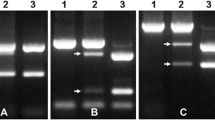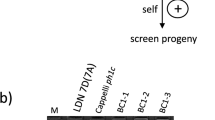Abstract
Powdery mildew is a serious fungal disease of wheat caused by Blumeria graminis f. sp. tritici. Chromosome 5U of Aegilops triuncialis carrying powdery mildew resistance was induced to recombine with chromosome 5A of wheat using ph1b deletion line. The resulting recombinant progeny lines were tested for resistance and screened with molecular markers. Among 367 progeny lines 8 were immune to powdery mildew, 53 were moderately resistant, 231 moderately susceptible and 75 highly susceptible. Screening of 5U/5A recombinant lines with 5A specific SSR markers indicated that a major powdery mildew resistance gene from A. triuncialis was introgressed on the long arm of wheat chromosome 5A, along with two other loci, one located in the terminal end of the same arm and the other on the short arm of 5A. Meiotic metaphase-I pairing indicated that chromosome pairing in the resistant recombinant lines was regular with 21 bivalents and high seed set. The DNA markers associated with the introgressions can be used in marker assisted selection for improved powdery mildew resistance in wheat.



Similar content being viewed by others
Abbreviations
- SSR:
-
Simple sequence repeats
- FAO:
-
Food and Agriculture Organization
- MAS:
-
Marker assisted selection
References
Alam MA, Xue F, Wang C, Ji W (2011) Powdery mildew resistance genes in wheat: identification and genetic analysis. J Mol Biol Res 1:20
Alam MA, Wang C, Ji W (2013) Chromosomal location and SSR markers of a powdery mildew resistance gene in common wheat line N0308. Afr J Microbiol Res 7:477–482
Blanco A, Gadaleta A, Cenci A, Carluccio AV, Abdelbacki AMM, Simeone R (2008) Molecular mapping of the novel powdery mildew resistance gene Pm36 introgressed from Triticum turgidum var. dicoccoides in durum wheat. Theor Appl Genet 117:135
Büschges R, Hollricher K, Panstruga R, Simons G, Wolter M, Frijters A, Daelen RW et al (1997) The barley Mlo gene: a novel control element of plant pathogen resistance. Cell 88:695–705
Chhuneja P, Kumar K, Stirnweis D, Hurni S, Keller B, Dhaliwal HS, Singh K (2012) Identification and mapping of two powdery mildew resistance genes in Triticum boeoticum L. Theor Appl Genet 124:1051–1058
Dhaliwal HS, Singh H, Gupta S, Bagga PS, Gill KS (1991) Evaluation of Aegilops and wild Triticum species for resistance to leaf rust (Puccinia recondita f. sp. tritici) of wheat. Int J Trop Agric 9:118–122
FAOSTAT (2017) Food and Agricultural Organization Statistical database, Crop production
Friebe B, Heun M, Tuleen N, Zeller FJ, Gill BS (1994) Cytogenetically monitored transfer of powdery mildew resistance from rye into wheat. Crop Sci 34:621–625
Gao H, Zhu F, Jiang Y, Wu J, Yan W, Zhang Q, Jacobi A, Cai S (2012) Genetic analysis and molecular mapping of a new powdery mildew resistant gene Pm46 in common wheat. Theor Appl Genet 125:967–973
Green JR, Carver TLW, Gurr SJ (2014) The formation and function of infection and feeding structures. In: Belanger RR, Bushnell WR, Dick AJ, Carver TLW (eds) The Powdery mildews: A comprehensive treatise, St. Paul, MN, USA: American Phytopathological Society (APS) Press pp 66–82
Hsam S, Zeller F (1997) Evidence of allelism between genes Pm8 and Pm17 and chromosomal location of powdery mildew and leaf rust resistance genes in the common wheat cultivar ‘Amigo'. Plant Breed 116:119–122
Leath S, Heun M (1990) Identification of powdery mildew resistance genes in cultivars of soft red winter wheat. Plant Dis 74:747–752
Li G, Feng T, Zhang H, Xie C, Li H, Yang T, Nevo E et al (2009) Molecular identification of a new powdery mildew resistance gene Pm41 on chromosome 3BL derived from wild emmer (Triticum turgidum var. dicoccoides). Theor Appl Genet 119:531–539
Liu Z, Sun Q, Ni Z, Nevo E, Yang T (2002) Molecular characterization of a novel powdery mildew resistance gene Pm30 in wheat originating from wild emmer. Euphytica 123:21–29
Liu N, Gong G, Zhang M, Zhou Y, Chen Z, Yang J, Chen H et al (2012) Over-summering of wheat powdery mildew in Sichuan Province, China. Crop Prot 34:112–118
Ma P, Zhang H, Xu H, Xu Y, Cao Y, Zhang X, An D (2015) The gene PmYB confers broad-spectrum powdery mildew resistance in the multi-allelic Pm2 chromosome region of the Chinese wheat cultivar YingBo 700. Mol Breed 35:124
McIntosh RA, Zhang P, Cowger C, Parks R, Lagudah ES, Hoxha S (2011) Rye-derived powdery mildew resistance gene Pm8 in wheat is suppressed by the Pm3 locus. Theor Appl Genet 123:359–367
Miranda L, Murphy J, Marshall D, Cowger C, Leath S (2007) Chromosomal location of Pm35, a novel Aegilops tauschii derived powdery mildew resistance gene introgressed into common wheat (Triticum aestivum L.). Theor Appl Genet 114:1451–1456
Murray MG, Thompson WF (1980) Rapid isolation of high molecular weight plant DNA. Nucleic Acids Res 8:4321–4326
Okamoto M (1957) Asynaptic effect of chromosome V. Wheat Inf Serv 5:6
Pannu P, Singh H, Datta R, Dhaliwal HS (1994) Screening of wild Triticum and Aegilops species for resistance to Karnal bunt disease of wheat. Bulletin des Ressources Phytogenetiques (IPGRI/FAO); Noticiario de Recursos Fitogeneticos (IPGRI/FAO)
Peleg Z, Saranga Y, Yazici A, Fahima T, Ozturk L, Cakmak I (2008) Grain zinc, iron and protein concentrations and zinc-efficiency in wild emmer wheat under contrasting irrigation regimes. Plant Soil 306:57–67
Piarulli L, Gadaleta A, Mangini G, Signorile MA, Pasquini M, Blanco A, Simeone R (2012) Molecular identification of a new powdery mildew resistance gene on chromosome 2BS from Triticum turgidum ssp. dicoccum. Plant Sci 196:101–106
Sears ER (1972) The nature of mutation in hexaploid wheat. Symp Biol Hung 12:73–82
Sears ER (1977) An induced mutant with homoeologous pairing in common wheat. Can J Genet Cytol 19:585–593
Sears E, Okamoto M (1958) Intergenomic chromosome relationships in hexaploid wheat. In: Proceedings of 10th International Congress of Genetics, pp 258–259
Sharma S, Xu S, Ehdaie B, Hoops A, Close TJ, Lukaszewski AJ, Waines JG (2011) Dissection of QTL effects for root traits using a chromosome arm-specific mapping population in bread wheat. Theor Appl Genet 122:759–769
Sharma M, Kaur S, Saluja M, Chhuneja P (2016) Mapping and characterization of powdery mildew resistance gene in synthetic wheat. Czech J Genet Plant Breed 52:120–123
Singh H, Tsujimoto H, Sakhuja P, Singh T, Dhaliwal HS (2000) Transfer of resistance to wheat pathogens from A. triuncialis into bread wheat. Wheat Inf Serv 91:5–10
Sun XL, Liu D, Zhang HQ, Huo NX, Zhou RH, Jia JZ (2006) Identification and mapping of two new genes conferring resistance to powdery mildew from Aegilops tauschii (Coss.) Schmal. J Integr Plant Biol 48:1204–1209
Wulff BB, Moscou MJ (2014) Strategies for transferring resistance into wheat: from wide crosses to GM cassettes. Front Plant Sci 5:692
Xu H, Yao G, Xiong L, Yang L, Jiang Y, Fu B, Zhao W et al (2008) Identification and mapping of pm2026: a recessive powdery mildew resistance gene in an einkorn (Triticum monococcum L.) accession. Theor Appl Genet 117:471–477
Xue F, Wang C, Li C, Duan X, Zhou Y, Zhao N, Wang Y, Ji W (2012) Molecular mapping of a powdery mildew resistance gene in common wheat landrace Baihulu and its allelism with Pm24. Theor Appl Genet 125:1425–1432
Zhang KP, Liang Z, Yan H, Guang-Feng C, Ji-Chun T (2008) QTL mapping for adult-plant resistance to powdery mildew, lodging resistance, and internode length below spike in wheat. Acta Agron Sin 34:1350–1357
Acknowledgements
The financial support provided by Department of Biotechnology, Government of India (BT/PR10886/AGII/106/934/2014) is duly acknowledged. The authors also acknowledge Akal College of Agriculture for providing necessary infrastructure and research facilities for carrying out this work.
Author information
Authors and Affiliations
Corresponding author
Ethics declarations
Conflict of interest
The authors declare that they have no conflict of interest.
Additional information
Publisher's Note
Springer Nature remains neutral with regard to jurisdictional claims in published maps and institutional affiliations.
Electronic supplementary material
Below is the link to the electronic supplementary material.
Rights and permissions
About this article
Cite this article
Kamboj, R., Sharma, S., Kumar, R. et al. Introgression of powdery mildew resistance from Aegilops triuncialis into wheat through induced homeologous pairing. J. Plant Biochem. Biotechnol. 29, 418–426 (2020). https://doi.org/10.1007/s13562-020-00548-x
Received:
Accepted:
Published:
Issue Date:
DOI: https://doi.org/10.1007/s13562-020-00548-x




